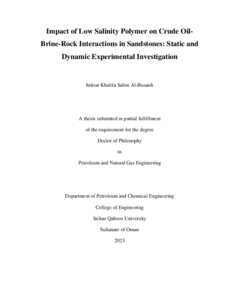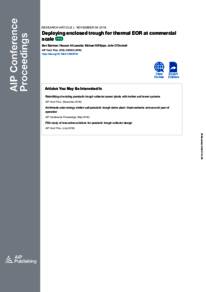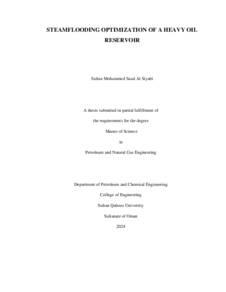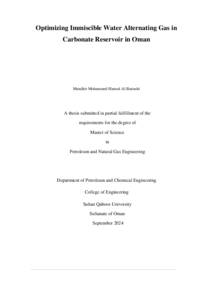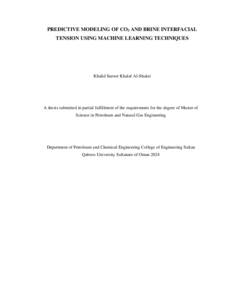Document
Impact of low salinity polymer on crude oil-brine-rock interactions in sandstones : static and dynamic experimental investigation.
Source
Doctoral dissertation
Other titles
تأثیر البولیمر منخفض الملوحة على تفاعلات النفط الخام مع الماء والصخر في المكامن الرملیة : دراسة مخبریة (ساكنة ودینامیكیة (
Country
Oman
City
Muscat
Publisher
Sultan Qaboos University
Gregorian
2023
Language
English
Subject
Thesis Type
Doctoral dissertation
English abstract
Recently, there has been a growing interest regarding the synergistic combination of
low salinity water with polymer flooding as a technique for enhanced oil recovery. Numerous
studies have been conducted to investigate the efficiency of low salinity polymer (LSP)
flooding in sandstone oil reservoirs; yet, there is no clear conclusion on the driving
mechanism. Research lacks detailed explanation on the influence of brine chemistry, polymer
characteristics, and rock mineralogy on the various aspects of crude oil/brine/rock (COBR)
interactions. Consequently, the relative contribution of rock/fluid or fluid/fluid interactions to
enhance oil recovery by LSP flooding is not well-understood. This study aims to scrutinize
the main factors controlling the oil recovery during LSP flooding by performing a systematic
experimental investigation of the interactions between crude oil, fluids and rock surface. Static
and dynamic experimental measurements were conducted using artificial and native reservoirs
systems (fluids and rocks) using brines of different chemistries. Rheological and fluid
properties of the injected and produced fluids were measured to establish a baseline and
quantify the main factors affecting the LSP flooding process. The impact of low salinity and
polymer flood on oil recovery was assessed using synthetic brines and native reservoir core
samples. The results revealed that the concentration of divalent cations and brine salinity
significantly influenced the electro-kinetic properties of the crude oil/brine and rock/brine
interfaces in the presence of polymer. The rock/brine interface became less negatively charged
with decreasing concentrations of divalent cations and brine salinity, while the oil/brine
interface became more negatively charged under the same conditions. Furthermore, reducing
the concentration of divalent cations or the salinity of the make-up brine showed a significant
impact on the viscoelasticity of polymer solutions but did not affect pH or the interfacial
tension (IFT). In addition, the presence of polymer in the brine was found to affect ion
exchange reactions, equilibration processes, and extending the stabilization time during
flooding experiments. Polymer molecules led to an increased concentration of divalent cations
in the effluent, which was more pronounced with decreasing brine salinity. Additionally, it
highlighted the greater influence of anion exchange reactions on pH of the effluent compared
to cation exchange. Moreover, LSP flooding showed better viscosity recovery, which can be
attributed to the relative change in cation and anion exchange reactions. LSP led to high
presence of sulfate ions in the effluent. The sulfate ions act as bridges between divalent
cations, preventing strong interactions with the polymer chains and maintaining viscosity
stability. The ratio of monovalent to divalent cations was identified as a major factor
influencing oil recovery by LSP flooding, regardless of rock mineralogy and injection
sequence mode, while pH and mineral dissolution had a minor effect. The viscoelasticity of
the crude oil/brine interface, influenced by factors such as oil viscosity and total acid number
(TAN), was found to be a crucial determinant of the success of LSP flooding. These results
have broad application and significance in LSP flooding for heavy oils to design LSP injection
strategies that yield improved oil recovery from sandstones reservoirs.
Arabic abstract
حالیا، هناك اهتمام مباستخدام تقنية الجمع بين المياه منخفضة الملوحة والبوليمر كتقنية لتعزيز استخراج النفط . هنالك العديد د من الدراسات حول تقییم كفاءة استخدام البولیمر منخفض الملوحة في مكامن النفط الرملیة. ومع ذلك، لا توجد استنتاجات واضحة بشأن آلیة عمل ھذه التقنیة. حیث تفتقر البحوث السابقة إلى شرح مفصل حول تأثیر كیمیاء الماء الملحي، وخصائص البولیمر، والمعادن المكونة للصخور على جوانب مختلفة من تفاعلات النفط الخام مع الماء الملحي والماء الملحي مع الصخر. وبالتالي فان مساھمة تفاعلات الصخور مع الماء الملحي أو النفط مع الماء الملحي في تعزیز استخراج ً . بناء دراسة العوامل الرئیسیة التي تتحكم في النفط بواسطة ھذه التقنیة تظل غیر واضحة على ذلك، یھدف ھذا البحث إلى استخراج النفط أثناء استخدام ھذه التقنیة من خلال فحص عینات من السوائل وصخور نموذجیة وصخور من مكامن رملیة محلیة. شملت ھذه القیاسات فحص سوائل البولیمر التي حضرت في محالیل ملحیة ذو تركیبات كیمیائیة مختلفة. بالإضافة إلى ذلك، تم تقییم تأثیر ھذه التقنیة على استخراج النفط باستخدام محالیل ملحیة صناعیة وعینات صخور من مكامن حجر رملیة. أظھرت النتائج أن تركیز الأیونات الموجبة ثنائیة الأیون وملوحة الماء تؤثر بشكل كبیر على الخصائص الكھرومغناطیسیة لتفاعلات النفط الخام مع الماء الملحي والماء الملحي مع الصخور بوجود البولیمر. حیث أصبح السطح الفاصل بین الصخر والماء الملحي ذو شحنة سالبة اقل مع انخفاض تركیز الأیونات الموجبة ثنائیة الأیون وملوحة المحلول الملحي، في حین أصبح السطح الفاصل بین النفط مع الماء الملحي ذو شحنة سالبة اعلى تحت نفس الظروف. علاوة على ذلك، أظھر تخفیض تركیز الأیونات الموجبة ً ثنائیة الأیون أو ملوحة الماء تأثیر ً ا كبیرا على لزوجة محالیل البولیمر بدون وجود أي تأثیر على درجة الحموضة أو التوتر السطحي. بالإضافة إلى ذلك، تبین أن وجود البولیمر في المحلول الملحي یؤثر على تفاعلات تبادل الأیونات وعملیات توازن التفاعلات بین الصخر والماء الملحي والنفط الخام، كما یزید من الوقت المطلوب للوصول الى مرحلة التوازن كما تبین من خلال نتائج تجارب الغمر. كما أدت جزیئات البولیمر إلى زیادة تركیز الأیونات الموجبة ثنائیة الأیون في السوائل المنتجة ً ، والتي كانت أكثر وضوحا مع انخفاض ملوحة المحلول الملحي. بالإضافة إلى ذلك، أظھرت جزیئات البولیمر تأثیر أكبر لتفاعلات تبادل الأیونات السالبة على درجة الحموضة في السوائل ُعزى ًا في استعادة لزوجة البولیمر، والذي یمكن أن ی المنتجة مقارنة بتبادل الأیونات الموجبة. كما أظھرت ھذه التقنیة تحسن إلى التغییر النسبي في تفاعلات تبادل الأیونات الموجبة والأیونات السالبة بسبب التركیز العالي لأیونات الكبریت في المحالیل المنتجة. تعمل أیونات الكبریت كجسور بین الأیونات الموجبة ثنائیة الأیون، مما یمنع التفاعلات القویة مع جزیئات البولیمر ویحافظ على استقرار اللزوجة. تم تحدید نسبة الأیونات الموجبة ذاتیة الأیون إلى ثنائیة الأیونات كعامل رئیسي یؤثر في استخراج النفط من خلال ھذه التقنیة بغض النظر عن المعادن المكونة للصخور وتسلسل حقن السوائل، في حین ًا. كما وجد أن لزوجة السطح الفاصل بین النفط الخام والماء الملحي أن درجة الحموضة وذوبان المعادن ً كان لھا تأثیرا طفیف والتي تتأثر بعوامل مختلفة كلزوجة النفط ورقمھ الحمضي تعتبر عوامل ً حاسمة في نجاح ھذه التقنیة. بالإضافة الى ذلك، نتائج ھذا البحث لھا تطبیق وأھمیة واسعة في مجال استخراج النفط الثقیل من مكامن الصخور الرملیة.
Category
Theses and Dissertations

